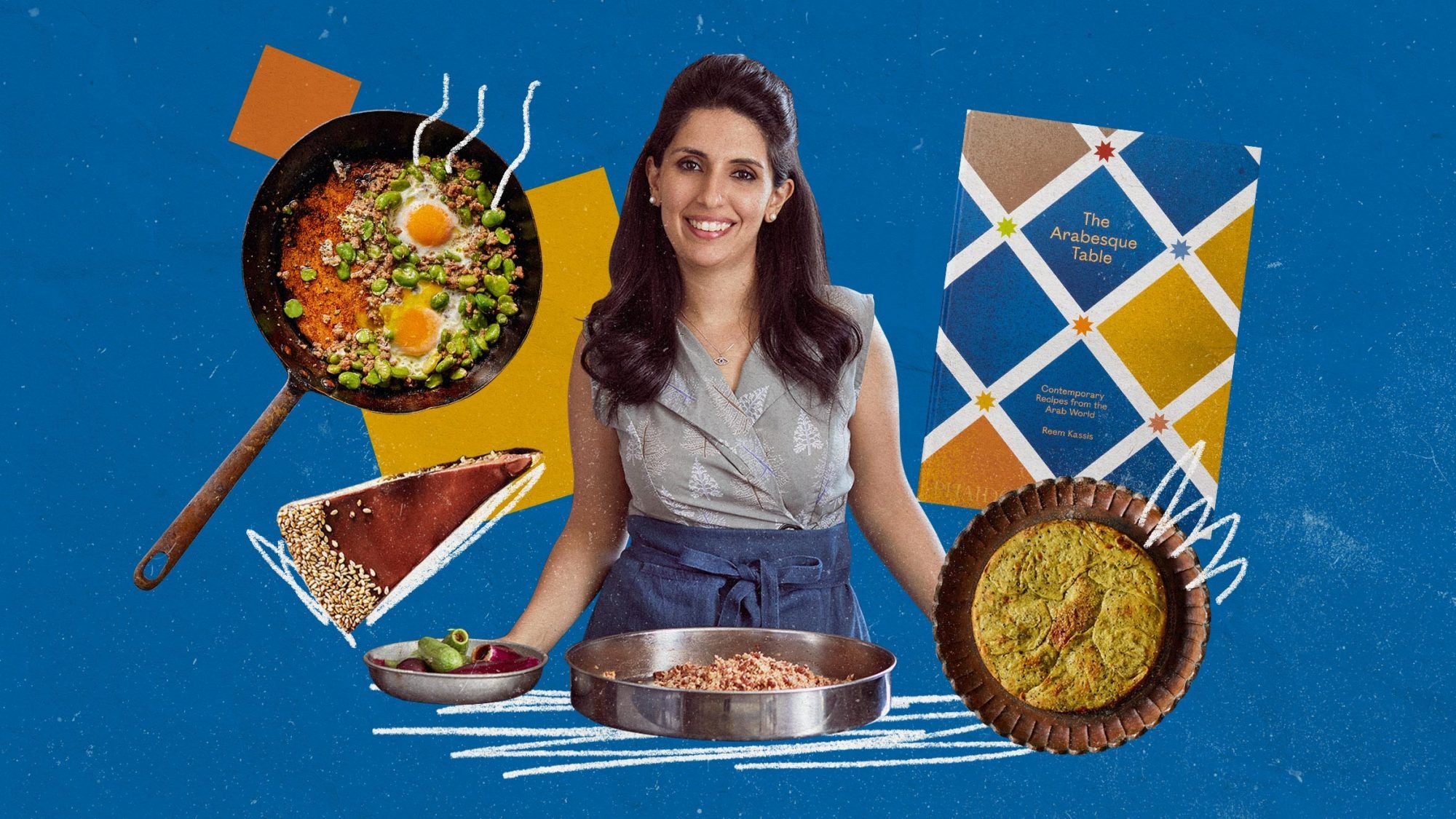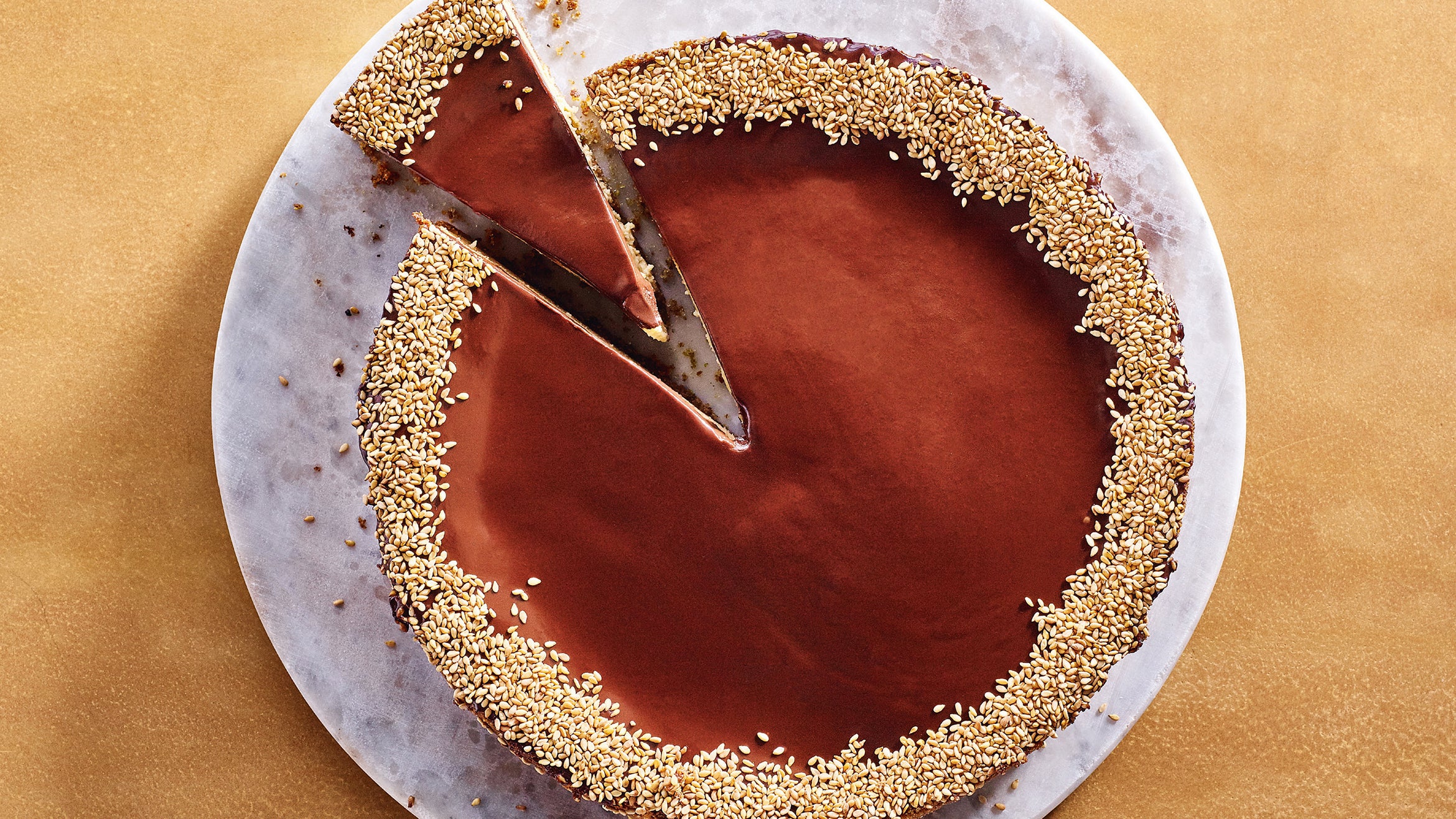
A new book by Reem Kassis considers the region’s centuries-long culinary journey through fusion, migration, and industrialization.
When Reem Kassis published her first book, The Palestinian Table, in 2017, she realized, time after time, that people are often temped to look at a country’s or region’s cuisine through a very narrow lens. They want to understand that cuisine through its “national” dishes, often stuck in a vacuum, on a concrete timeline with a beginning and an end, and without any of the nuances and intricacies that fuse elements of different cultures over time.
Kassis’s rebuttle to this notion is The Arabesque Table, which spans the geographic area that now comprises 22 countries stretching from the Atlantic Ocean to the Arabian Sea. The “Arabesque” in the book’s title refers to the ubiquitous ornamental design that appears in Arab and Islamic art (and on the book’s jacket). As Kassis writes, “No cuisine is a straight line stretching infinitely back in time. Rather, it is just like an arabesque pattern, flowing and intertwined, its beauty not intrinsic but enriched by the kaleidoscope of interlaced and potentially infinite designs that inspired this title.”
I recently talked to Kassis about some of those intricacies she honored in The Arabesque Table. The culinary history, as told through the book, extends to her own Philadelphia home kitchen, with all its weekly rhythms and East Coast ingredients. Mussels are simmered in arak and saffron. Maqlubeh, a layered chicken and rice dish that’s usually reserved for big weekend gatherings, is reimagined in a version that could work for dinner on a Tuesday. A New York–style cheesecake even makes an appearance.
Your first book, The Palestinian Table, came out in 2017. What made The Arabesque Table the natural follow-up?
I always said The Palestinian Table would be my first and last book, ha! But soon after it came out, I was regularly being asked in interviews about the difference between various national cuisines, like Palestinian versus Lebanese versus Syrian. As I started researching this more and more, I realized that our perception of cuisine is flawed, because our time frame is, at best, a couple hundred years—when, in fact, the history of cuisine stretches back to the start of civilization. I wanted to show this journey over time, and how food is inherently intertwined and cross-cultural, even as it remains crucial to defining a national identity—i.e., that those two things are not mutually exclusive.
The Arabesque Table arose out of that understanding and desire to explain this journey, but also out of frustration at seeing how many books were coming out claiming to be one national cuisine or another, when they were, at best, fusion. Fusion itself is wonderful and, in fact, not new to Arab cuisine—centuries of migration, occupation, and trade have left their mark on our food. But what I felt was lacking was an honest conversation about what was traditional, what was modern, and what was a cross-cultural integration of multiple culinary traditions. To be able to showcase what a modern Arab table looks like today with any semblance of integrity, we have to place it in the context of the entire culinary history of the Arab world and the journey that brought us to this point—and that’s what The Arabesque Table tries to do.
Were there any particular misconceptions about Arabic food that you wanted to overcome with the book?
One misconception I wanted to address was this idea of “Middle Eastern” cuisine. The very term “Middle East” is an imperialistic, Eurocentric view of our part of the world, and it’s a term lacking any specificity. It’s what we were to the British Empire, relative to their farthest eastern colony of India. We continue to use the term “Middle East” in the culinary world, usually without specificity, because it’s sensually evocative and easy to grasp, but its definitions often overlap and change according to shifting perspectives (e.g., some include Iran and Turkey, others add in some countries of the Mediterranean, and others yet will include North Africa and different parts of the Islamic world, none of which are technically Middle Eastern). What really unites our region is the collective culture that has been shaped by a common history involving a long acculturation process under Arab and Islamic rule.
Another major misconception that I discovered and wanted the book to highlight was this idea that Arab cuisines borrowed a lot from Ottoman cuisine. This couldn’t be further from the truth, because it is the exact opposite. The very first Ottoman cookbook was nothing more than a translation of a 10th-century Arabic cookbook (Kitab al-Tabikh), which I reference heavily in my book.
Digging into the culinary history of the Arabic world, were there any major revelations you discovered? Connections that you never realized between particular places or dishes or ingredients?
I discovered just how influential Arab cuisine has been on the cuisines of the entire world. For example: The very idea of a milk pudding thickened with starch was brought to Europe by Arab traders—so think of panna cotta, blancmange, and any other pudding you find, and its origins can be traced back to Arab cuisine.
The bagel also has Arab origins, because the first mention of a boiled then baked ring of dough was mentioned in a 13th-century Arabic cookbook long before the currently presumed 16th-century Poland.
You wrote the book from your home in Philadelphia, and there are a few moments in the text where you talk about modernizing or adapting traditional dishes to work with your own cooking habits (like the weeknight version of maqlubeh!). Were there any recipes that especially surprised older generations in your family (or even ruffled feathers)?
Haha! I wouldn’t say anything ruffled feathers, but older generations definitely looked at maqlubeh, and the stuffed cabbage pie, and the Swiss chard khubeizeh, and said that those aren’t the real deal even if they are good. But they were what I could do given the circumstances, and, in my opinion (at least for the cabbage), they were better than the original.
What were the most difficult ingredients or pieces of produce to find in Philly?
Kousa, sold here as Mexican gray squash, is one of the ingredients I struggle to find, and, if and when I do find it, it’s too large or not fresh enough. That’s why you see no recipes including it, even though it is a staple in our cuisine.
Other ingredients like labaneh, freekeh, za’atar, and sumac are easier to find these days, but for me, having tasted the original versions made back home with local, native ingredients, I see those items here as nowhere near the amazing flavor of the originals.
I’m especially excited to make the tahini cheesecake with chocolate glaze and sesame seeds. What’s the story behind this spin on the New York cheesecake template?
I wish there was a fascinating story behind it, but it’s quite mundane. I love tahini in everything (I’ve made so many desserts with it, and many were disasters—hence not in the book. Ha!). I’m not a big fan of cheesecake because I find it too sweet and too uniform in flavor. One time, I had friends coming over for a dinner party, and they were familiar with Arabic food. So, in an effort to do something more novel, I tried this twist on the cake, and it was a total winner. The tahini takes the cloyingly sweet edge off the cake, and its nutty bitterness adds a layer of depth or another dimension to the usually monotonous flavor.

THREE EXCITING RECIPES FROM THE ARABESQUE TABLE:
Tahini Cheesecake with Chocolate Glaze and Sesame Seeds
This just might be the spin on the New York classic you’ve been waiting for.
Narjissiyeh
One of the brightest, simplest ways to eat favas.
Makmoora
This savory pie centerpiece will give your chicken pot pie a run for its money.
MORE BOOKS TO BUY, READ, AND COOK FROM:
Last week, Kayla Stewart spoke to author Anas Atassi about his new book, Sumac: Recipes and Stories from Syria.
Curious to dive into some of the grains beyond AP flour in your cupboard? Roxana Jullapat has you covered with Mother Grains.
Bress ‘n’ Nyam weaves together Gullah Geechee culinary history with author Matthew Raiford’s own experiences as a chef and sixth-generation farmer.
Start planning your summer picnics the French way with Rebekah Peppler’s À Table.
Chicano Eats, by Esteban Castillo, has become a classic in some of our kitchens—especially the book’s mind-boggling,